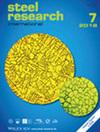评估生物炭和焦炭混合物在电弧炉炼钢中的炉渣发泡应用
IF 1.9
3区 材料科学
Q2 METALLURGY & METALLURGICAL ENGINEERING
引用次数: 0
摘要
电弧炉(EAF)是实现钢铁工业脱碳的一种前景广阔的方法。在电弧炉炼钢过程中,向熔渣中注入碳对于形成泡沫状熔渣仍然至关重要,因为泡沫状熔渣可以提高工艺的能效并保护熔炉。生物炭(BC)已成为传统化石碳在熔渣发泡方面的潜在替代品。然而,用 BC 完全替代化石碳在技术上存在挑战。在本研究中,考虑了用 BC 部分替代化石碳,即石油焦(petcoke)和 BC 混合物的形式。有趣的是,由于协同效应,石油焦和萃取碳的混合物与单独使用其中一种碳的效果相当,甚至可能优于单独使用其中一种碳的效果。使用感应炉模拟 EAF 条件,熔化合成炉渣,并在炉渣层中加入喷射碳。研究了石油焦、BC 和三种混合物的炉渣发泡效果。热重分析表明,与石油焦相比,BC 与炉渣的反应性更强,从而导致最初高强度的 CO 生成。然而,CO 的生成并不连续或一致。综合所有实验结果,提出了 BC 混合物渣发泡行为的机理描述。本文章由计算机程序翻译,如有差异,请以英文原文为准。
Evaluation of Biochar and Coke Blends for Slag Foaming Applications in Electric Arc Furnace Steelmaking
The electric arc furnace (EAF) is a promising approach to decarbonize the iron and steel industry. In EAF steelmaking, injecting carbon into the molten slag remains crucial for creating a foamy slag, which enhances the energy efficiency of the process and protects the furnace. Biochar (BC) has emerged as a potential alternative to traditional fossil carbon for slag foaming. However, fully replacing fossil carbon with BC poses technical challenges. In this study, the partial replacement of fossil carbon with BC is considered, in the form of a petroleum coke (petcoke) and BC blend. Interestingly, a blend of petcoke and BC matches or possibly outperforms either carbon type individually, due to a synergistic effect. Using an induction furnace to simulate EAF conditions, a synthetic slag is melted, and injection carbon is added into the slag layer. The slag foaming effectiveness of petcoke, BC, and three blend cases are studied. Thermogravimetric analysis reveals that the BC is more reactive with slag compared to petcoke, which leads to an initial high intensity of CO generation. However, the CO generation was not continuous or consistent. All experimental results are combined to propose a mechanistic description of the slag foaming behavior of BC blends.
求助全文
通过发布文献求助,成功后即可免费获取论文全文。
去求助
来源期刊

steel research international
工程技术-冶金工程
CiteScore
3.30
自引率
18.20%
发文量
319
审稿时长
1.9 months
期刊介绍:
steel research international is a journal providing a forum for the publication of high-quality manuscripts in areas ranging from process metallurgy and metal forming to materials engineering as well as process control and testing. The emphasis is on steel and on materials involved in steelmaking and the processing of steel, such as refractories and slags.
steel research international welcomes manuscripts describing basic scientific research as well as industrial research. The journal received a further increased, record-high Impact Factor of 1.522 (2018 Journal Impact Factor, Journal Citation Reports (Clarivate Analytics, 2019)).
The journal was formerly well known as "Archiv für das Eisenhüttenwesen" and "steel research"; with effect from January 1, 2006, the former "Scandinavian Journal of Metallurgy" merged with Steel Research International.
Hot Topics:
-Steels for Automotive Applications
-High-strength Steels
-Sustainable steelmaking
-Interstitially Alloyed Steels
-Electromagnetic Processing of Metals
-High Speed Forming
 求助内容:
求助内容: 应助结果提醒方式:
应助结果提醒方式:


